17 Best Native Plants for Murfreesboro, TN
BY KIMBERLY MAGERL | APRIL 12TH, 2023 | LAWN CARE, MURFREESBORO, TENNESSEENamed the Most Livable Town in Tennessee, Murfreesboro offers excellence in education, medical facilities, employment opportunities, real estate, and recreational programs. Located in the Nashville metropolitan area of middle Tennessee, the city houses over 1,200 acres of award-winning parks and outdoor spaces.
Murfreesboro is the 3rd Fastest Growing City in America. The small city has a lot of urban amenities and all the country charm you could ever dream of. Invite some Tennessee nature and southern beauty into your landscape by filling your yard with some of the best native plants for Murfreesboro.
Native plants offer many landscaping benefits, including:
- Native plants support a diverse ecosystem, providing food and shelter for local wildlife, birds, and insects.
- They are acclimated to the humid subtropical climate and four distinct seasons.
- They are low-maintenance, surviving Tennessee frost, local insects, and disease.
Native plants help promote a healthier Tennessee ecosystem. Check out these 17 native plants for Murfreesboro to help you plan your charming landscape.
In this article, we’ll cover:
- 17 Native Plants for Your Murfreesboro Yard
- How to Choose Native Plants for Your Murfreesboro Landscape
- FAQ About Native Murfreesboro Plants
- Where to Find Native Plants in Murfreesboro
17 Native Plants for Your Murfreesboro Yard
1. American Persimmon (Diospyros virginiana)
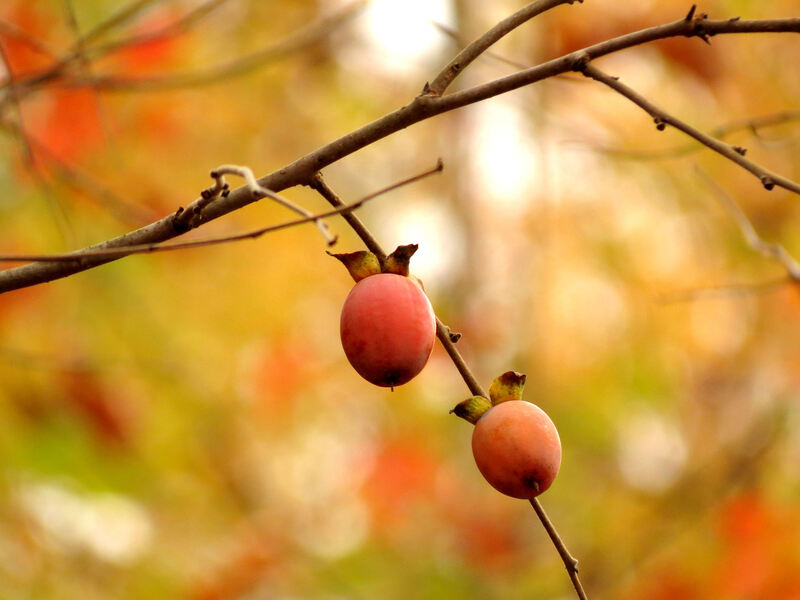
Photo Credit: Katja Schulz / Flickr / CC BY 2.0
American persimmon, also known as common persimmon and eastern persimmon, is a small to medium-sized tree that reaches heights up to 80 feet tall. Native to Tennessee and the Eastern United States, this shade tree produces small white and yellow flowers followed by edible orange fruits in September and December.
American persimmons have a short trunk and spreading growth habit with a broad and rounded canopy. The tree invites local wildlife such as pollinators, songbirds, deer, and flying squirrels, and is the larval host for the Luna moth. Persimmon trees grow well in all soil types and habitats, from shaded valleys and home lawns to wide-open sunny fields and the shores of Percy Priest Lake.
Growth habit: Tree
USDA hardiness zone: 4-9
Mature size: 30-80 feet tall and 25-35 feet wide
Duration: Perennial
Foliage: Deciduous
Sunlight needs: Full sun to partial shade
Soil preferences: Adaptable; low-nutrient, rich, acidic, alkaline, neutral, moist, well-drained, poorly drained, loam, sand, silt, soil, rock, or clay
Water needs: Drought-tolerant; water 1 inch per week if it does not rain and allow to dry out between waterings
Potential hazards: Non-toxic; edible fruits
2. American Witch-Hazel (Hamamelis virginiana)
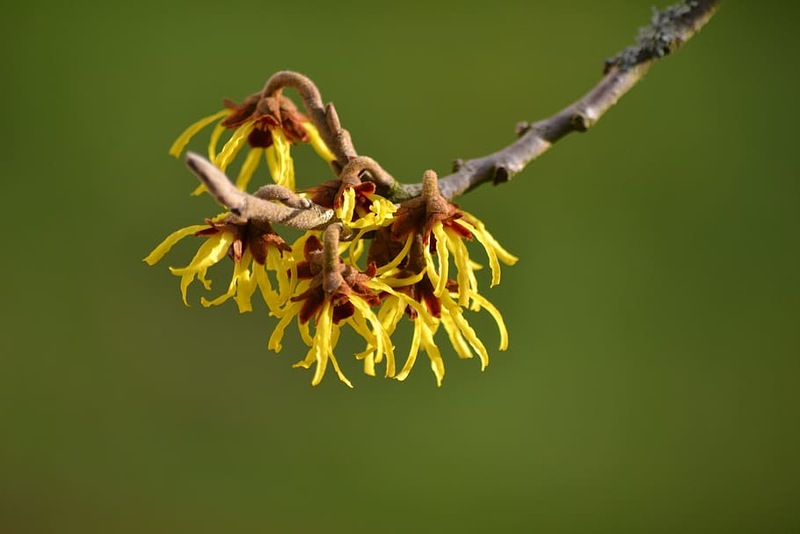
Photo Credit: Pxfuel
American or common witch-hazel is a small deciduous tree with a vase-shaped growth habit found in Tennessee and the Eastern United States. It has scaly, light brown bark, oval leaves, and small, spindly yellow flowers that bloom in fall. The small tree produces wood fruit following its fragrant fall blooms, and its leaves turn a clear yellow in autumn.
American witch-hazel loves shady areas and adapts to most soil conditions. The large shrub is often found in wetlands, woodlands, and stream banks. Witch-hazel grows well as fringe trees in home lawns that back up to wooded areas. The tree also makes a great border shrub and grows extremely well under the canopy of a large shade tree for landscape dimension.
Growth habit: Small tree or large shrub
USDA hardiness zone: 3-9
Mature size: 10-20 feet tall and wide
Duration: Perennial
Foliage: Deciduous
Sunlight needs: Partial shade to full shade
Soil preferences: Adaptable; low-nutrient, rich, acidic, alkaline, neutral, moist, well-drained, loam, sand, silt, or soil
Water needs: Natural rainwater is sufficient; may need 1 inch of water per week during extremely dry conditions
Potential hazards: Non-toxic; no safety hazards
3. Aster (Asteraceae)
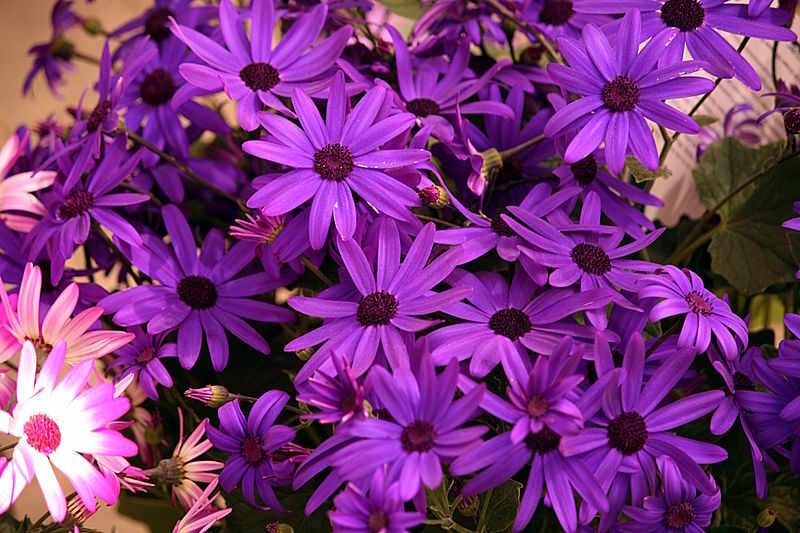
Photo Credit: Hedwig Storch / Wikimedia Commons / CC BY 3.0
Asters are a family of flowering perennials with several species native to Tennessee. Vibrant late summer and early fall blooms attract pollinating insects, while the dried stalks and leftover seeds provide food and shelter for songbirds in the winter.
Asters prefer full sun and thrive in the well-drained loamy soils found in Murfreesboro. Plant these beautiful blooms in flower beds, containers, or butterfly gardens. The three most prominent asters native to Tennessee include:
- Rockcastle aster (Eurybia saxicastelli): Native only to Tennessee and Kentucky, this aster has dark green leaves and white to yellow daisy-like blooms with yellow centers.
- Raydon’s Favorite (Symphyotrichum oblongifolium): Originating near Lookout Mountain in southeastern Tennessee, this fall aster blooms showy light purple flowers with bright yellow centers.
- Rachel Jackson (Symphyotrichum oblongifolius): This aster is another fall-blooming herbaceous perennial with daisy-like vibrant purple blooms with bright yellow centers.
Growth habit: Herbaceous flower
USDA hardiness zone: 4-8
Mature size: 1-6 feet tall and 1-4 feet wide
Duration: Perennial
Foliage: Deciduous
Sunlight needs: Full sun
Soil preferences: Prefer neutral or acidic well-drained loamy soil
Water needs: Drought-tolerant; may need weekly watering during extreme dry spells; do not tolerate standing water
Potential hazards: Non-toxic; edible flowers
4. Bee Balm (Monarda fistuloasa)
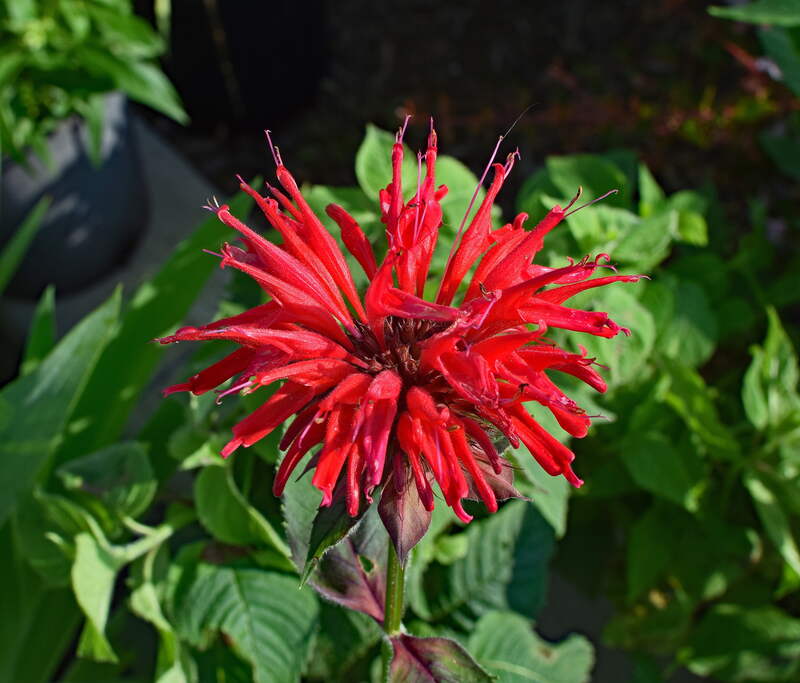
Photo Credit: PxFuel
Wild bergamot, affectionately known as bee balm, is a Tennessee wildflower in the mint family. It blooms in the summer with showy white or purple flowers that look like pom-poms. Bee balm grows well in garden beds and containers. The subshrub is often used as a medicinal plant or honey plant in pollinator gardens.
The perennial has aromatic leaves that can be used for mint tea. Its medicinal properties are often used to treat respiratory ailments. Wild bergamot reaches up to 5 feet and grows well in all soil types, but does not tolerate flooding. The fragrant shrub attracts many pollinators to your garden but, like all plants in the mint family, is resistant to deer and mosquitoes.
Growth habit: Herb or subshrub
USDA hardiness zone: 3-8
Mature size: 2-5 feet tall
Duration: Perennial
Foliage: Deciduous
Sunlight needs: Full sun to partial shade
Soil preferences: Adaptable; prefers well-drained acidic soil, sandy loam, loam, clay, or lime-based soil
Water needs: Drought tolerant; water every 7-10 days during dry periods
Potential hazards: Non-toxic; edible leaves and flowers; medicinal uses for respiratory ailments
5. Butterfly Milkweed (Asclepias tuberosa)
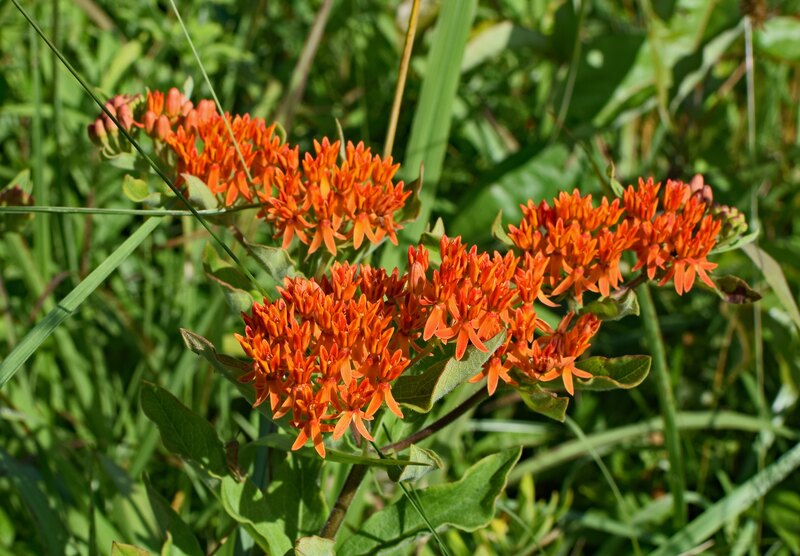
Photo Credit: PxFuel
Butterfly weed is a native species of milkweed and is extremely important to healthy Tennessee landscapes. It is an attractive flowering plant and a nectar source for bees and pollinators and a host plant for caterpillars, including the Monarch butterfly, Dogbane Tiger moth, and Milkweed Tussock moth. There are around 14 native species of milkweed that call Tennessee home.
Butterfly weed produces bright orange or yellow flowers from summer to fall. The attractive plant is hardy and loves full sun. It tolerates most soils but prefers sandy well-draining soil and is moderately drought-tolerant.
Growth habit: Flower
USDA hardiness zone: 3-10
Mature size: 1-4 feet tall and less than 1 foot wide
Duration: Perennial though some species are annuals
Foliage: N/A
Sunlight needs: Full sun
Soil preferences: Prefers dry, sandy soil or gravel
Water needs: Semi drought-tolerant; prefers to dry out between waterings
Potential hazards: Low toxicity; milky sap irritates humans and animals
6. Eastern Redbud (Cercis canadensis)
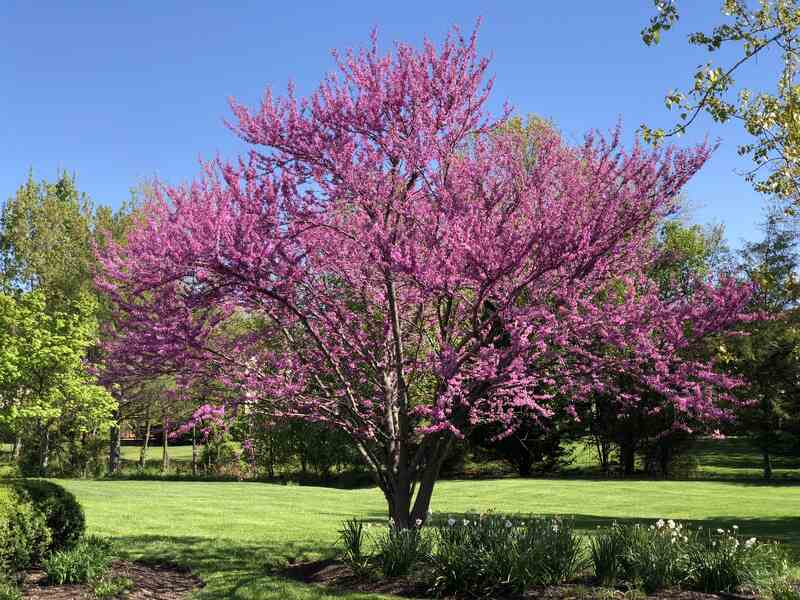
Photo Credit: Famartin / Wikimedia Commons / CC BY-SA 3.0
Eastern redbud, or Tennessee pink to the locals, is a small deciduous tree with a dense canopy. It produces small clusters of showy pink flowers over its bare branches in spring. Blooms last for two to three weeks before giving way to heart-shaped dark green leaves that turn golden in the fall.
Tennessee pink works well as shrub borders and fringe trees. Those low-maintenance cultivars require little pruning and attract many birds and pollinators. They have a short trunk and rounded crown of spreading branches. Unfortunately, these beautiful trees have a short lifespan of around 50 years.
Growth habit: Tree
USDA hardiness zone: 3-8
Mature size: Up to 30 feet tall
Duration: Perennial
Foliage: Deciduous
Sunlight needs: Partial to full shade
Soil preferences: Prefers moist, fertile, well-drained soil
Water needs: Water once weekly during dry spells
Potential hazards: High toxicity; poisonous to dogs and cats
7. Flowering Dogwood (Cornus Florida)
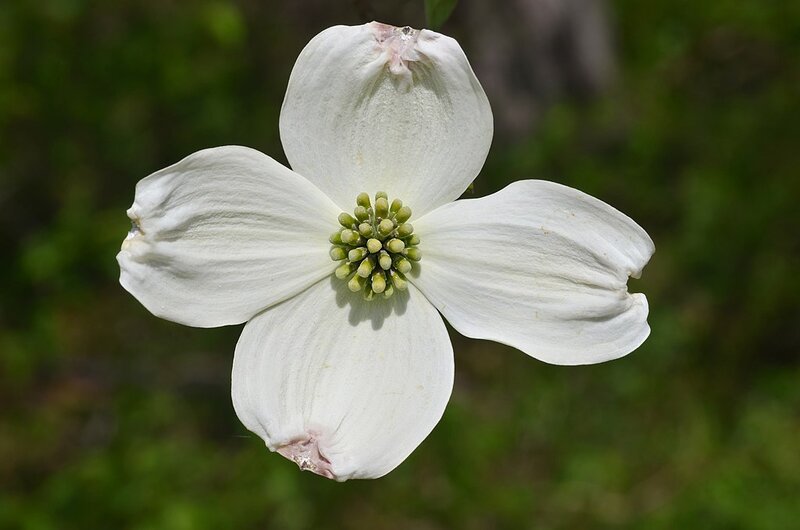
Photo Credit: Derek Ramsey / Wikimedia Commons / CC BY-SA 4.0
Flowering dogwood is a small flowering understory tree. Producing one of the most popular and recognizable spring flowers in Murfreesboro, this small tree blooms white or pink flowers of modified leaves in April and May and produces bright red berries in the fall.
Flowering dogwood is single or multi-trunked with sprawling branches. Plant anywhere your yard receives shade and filtered light. The berries of this small tree provide food for birds, deer, and small mammals while its flowers attract Tennessee pollinators. Flowering dogwood is also a larval food source for the Spring Azure butterfly.
Growth habit: Tree
USDA hardiness zone: 5-9
Mature size: 15-30 feet tall and wide
Duration: Perennial
Foliage: Deciduous
Sunlight needs: Partial shade to full shade
Soil preferences: Prefers rich, acidic, well-drained, soil, sand, loam, or medium loam
Water needs: Water 1 inch per week in place of rainfall
Potential hazards: Moderate toxicity; fruit is poisonous to humans
8. Lemon Mint (Monarda citriodora)
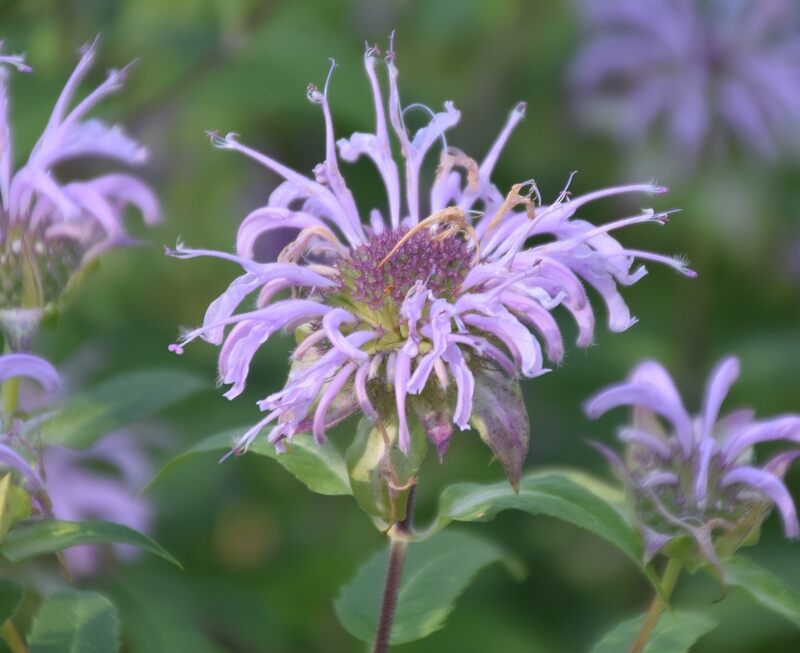
Photo Credit: Krzysztof Golik / Wikimedia Commons / CC BY-SA 4.0
Another member of the mint family, lemon mint, also known as lemon bee balm and purple horsemint, is an aromatic winter annual native to Tennessee. It produces unique, tufted, whorled lavender-pink flowers on elongated spikes in the spring through fall. This drought-tolerant plant requires annual reseeding in Murfreesboro.
Like all plants in the mint family, horsemint is used for tea and has a distinctive citrus-lemon mint scent that attracts bees and butterflies but repels mosquitoes and deer. It grows in all soil conditions and is commonly found alongside Tennessee highways, pastures, hillsides, prairies, savannahs, and plains. Lemon mint is low-maintenance and aggressive and prefers to be left alone. The winter annual grows well in garden beds or along garden margins, anywhere it will be neglected.
Growth habit: Herb or subshrub
USDA hardiness zone: 5-9
Mature size: Up to 30 inches tall and 7-12 inches wide
Duration: Short-lived perennial or annual
Foliage: Deciduous
Sunlight needs: Full sun to partial shade
Soil preferences: Adaptable; prefers sandy loam, rock, clay loam, medium loam, sand, or clay
Water needs: Prefers regular watering to keep the soil moist; grows well with a layer of mulch to retain moisture
Potential hazards: Non-toxic; edible leaves and flowers used for tea, salads, and cooked foods
9. Mapleleaf Viburnum (Viburnum acerifolium)
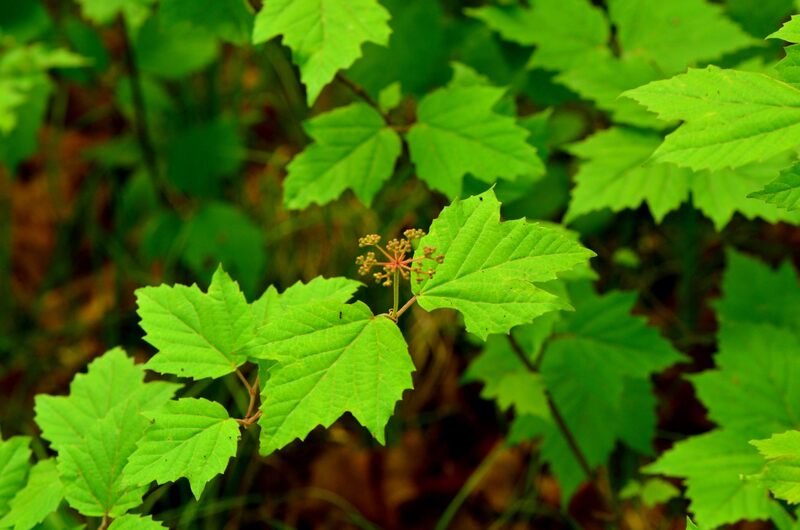
Photo Credit: Joshua Mayer / Flickr / CC BY-SA 2.0
Mapleleaf viburnum is a low-growing, dense shrub. It has bright green maple-shaped deciduous foliage that turns shades of pink and purple in the fall. The attractive shrub blooms white flowers in the spring followed by berries in late summer and early fall that turn from red to dark blue.
Mapleleaf viburnum grows best in partial shade. The low-maintenance shrub grows well alone and in clusters and responds well to pruning after they bloom. Its berries attract birds and other wildlife and it is a larval food source for the Spring Azure butterfly.
Growth habit: Shrub
USDA hardiness zone: 4-8
Mature size: 4-6 feet tall and 3-4 feet wide
Duration: Perennial
Foliage: Deciduous
Sunlight needs: Partial shade to full shade
Soil preferences: Prefers dry, acidic, rock, sand, loam, medium loam, clay loam, or clay
Water needs: Drought-tolerant; may need weekly watering during extreme dry spells
Potential hazards: Non-toxic; no safety hazards
10. Oakleaf Hydrangea (Hydrangea quercifolia)
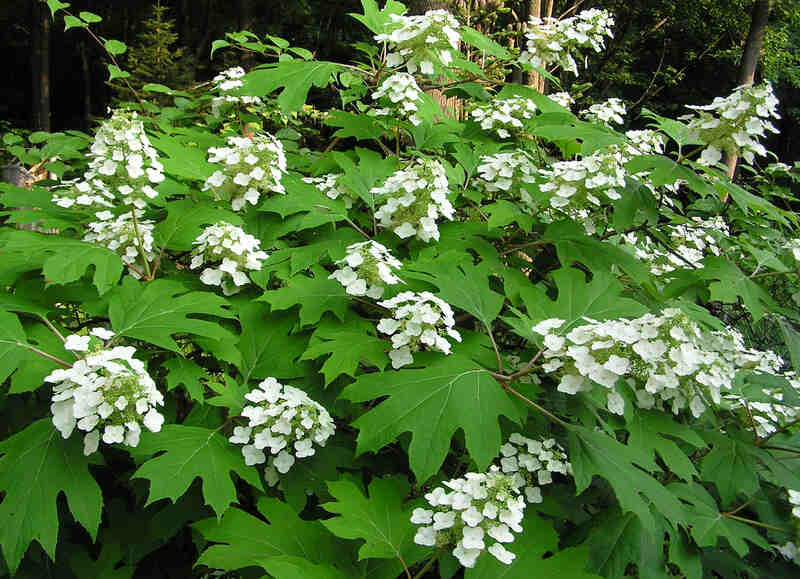
Photo Credit: normanack / Flickr / CC BY 2.0
Oakleaf hydrangea is a shade-loving shrub found in the understory of large trees like Tennessee black walnuts, maples, and dogwoods. It is coarse-textured with large, cone-shaped flower clusters that bloom for months every summer and change colors from white to light pink and purple.
The fast-growing deciduous shrub gets its name from its dark green, oak-shaped leaves that turn red, gold, or purple in the fall. Oakleaf hydrangea reaches heights up to 10 feet tall and thrives in fertile, well-drained soil. Smaller cultivars like “Pee Wee” are available for homeowners with limited space.
Growth habit: Shrub
USDA hardiness zone: 5b-9
Mature size: 6-10 feet high and 6-8 feet wide
Duration: Perennial
Foliage: Deciduous
Sunlight needs: Full shade to partial shade
Soil preferences: Prefers, fertile, well-drained soil; adapts to most soil conditions, including moist, acidic soil
Water needs: Moderately drought-tolerant; prefers moist soil
Potential hazards: Toxic; all plant parts are poisonous to humans and animals
11. Sugar Maple (Acer saccharum)
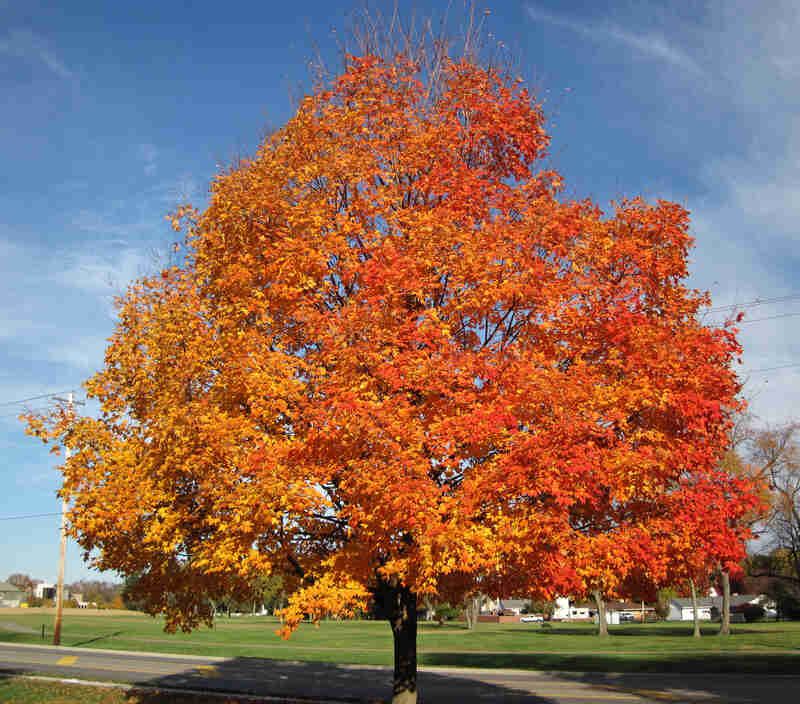
Photo Credit: James St. John / Flickr / CC BY 2.0
Sugar maple is a native deciduous tree with sap used to make maple syrup. It is a large tree, growing 40 to 80 feet tall in most landscapes. Sugar maple has a dense, rounded crown with foliage that turns yellow, orange, red, and bronze in the fall. It has shaggy brown bark and widespread branches.
Sugar maple produces hardwood used for home furniture and flooring. It prefers full sun and well-drained soil. Keep in mind that this shade tree has shallow roots that can disrupt the growth of plants and grass growing under its canopy.
Growth habit: Tree
USDA hardiness zone: 3-8
Mature size: 40-80 tall feet and 30-60 feet wide
Duration: Perennial
Foliage: Deciduous
Sunlight needs: Full sun to partial shade
Soil preferences: Deep, well-drained, acidic or slightly alkaline soil
Water needs: Water every 3-5 days, especially in dry conditions
Potential hazards: Moderate toxicity; only poisonous to horses
12. Spicebush (Lindera benzoin)
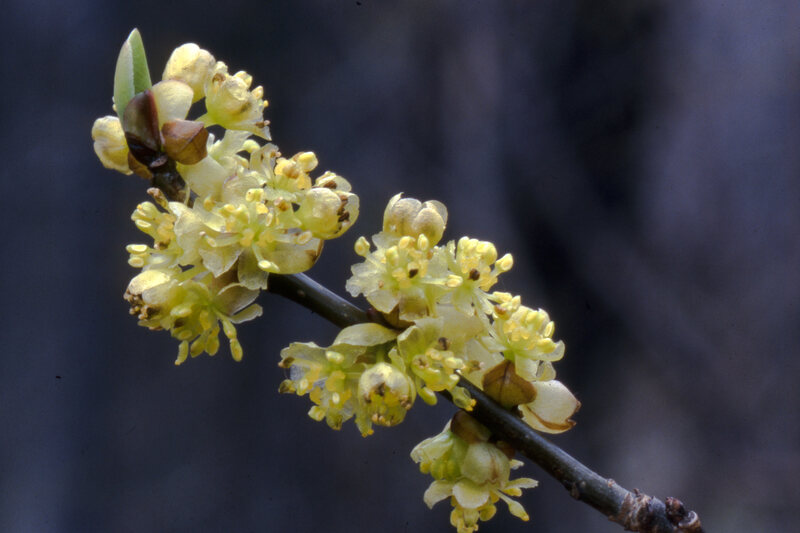
Photo Credit: NatureServe / Flickr / CC BY 2.0
Spicebush is an ornamental shrub that is disease and pest-resistant. It produces small bright yellow, fragrant flowers in spring and bright red berries in September. The multi-stemmed shrub has medium green leaves that turn clear yellow in fall. It occurs naturally in wooded areas and pond shores, preferring fertile loam soils.
Spicebush adapts to a range of lighting conditions, from full sun to full shade. It is an important plant for the Tennessee ecosystem. This shrub attracts birds and pollinators and is the nesting ground for the Spicebush Swallowtail. Grow spicebush in dappled shade covered with organic mulch. It is ideal for woodland gardens, borders, mass plantings, and landscapes near streams or ponds.
Growth habit: Shrub
USDA hardiness zone: 4-9
Mature size: 6-12 feet tall and wide
Duration: Perennial
Foliage: Deciduous
Sunlight needs: Full sun to heavy shade
Soil preferences: Adaptable; prefers acidic or alkaline, fertile loam; will tolerate loamy sand, medium loam, and silty loam
Water needs: Adaptable; does not require watering outside of rainfall
Potential hazards: Non-toxic; edible leaves and berries
13. Tennessee Coneflower (Echinacea tennesseensis)
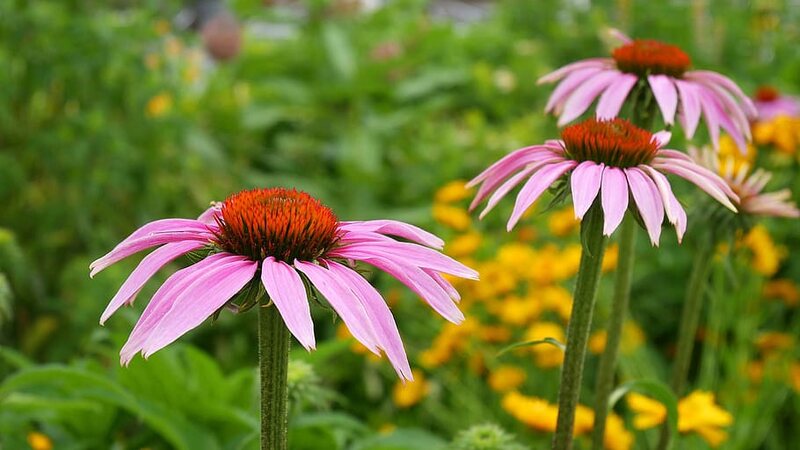
Photo Credit: Wallpaperflare
Tennessee coneflower was on the verge of extinction until 2011 when officials removed it from the endangered species list. This Tennessee native is slow-growing and perfect for prairies, meadows, flower beds, containers, and rock gardens. Tennessee coneflower produces bright fuchsia daisy-shaped blooms with burgundy and orange centers atop long vertical stems.
These vibrant wildflowers tolerate drought, humidity, heat, and poor soils, and have no serious pest or disease issues. Coneflowers attract butterflies, hummingbirds, and other pollinators, but also make a great deer-resistant addition to your Murfreesboro lawn. They are also an important food source for winter songbirds.
Growth habit: Herbaceous flower
USDA hardiness zone: 5-9
Mature size: 18-24 inches tall and 12-18 inches wide
Duration: Perennial
Foliage: Deciduous
Sunlight needs: Full sun
Soil preferences: Adaptable; prefers well-drained, acidic, alkaline, neutral, chalk, loam, or sand
Water needs: Drought-tolerant; requires weekly watering during extreme dry periods
Potential hazards: Non-toxic; edible
14. Wild Geranium (Geranium maculatum)
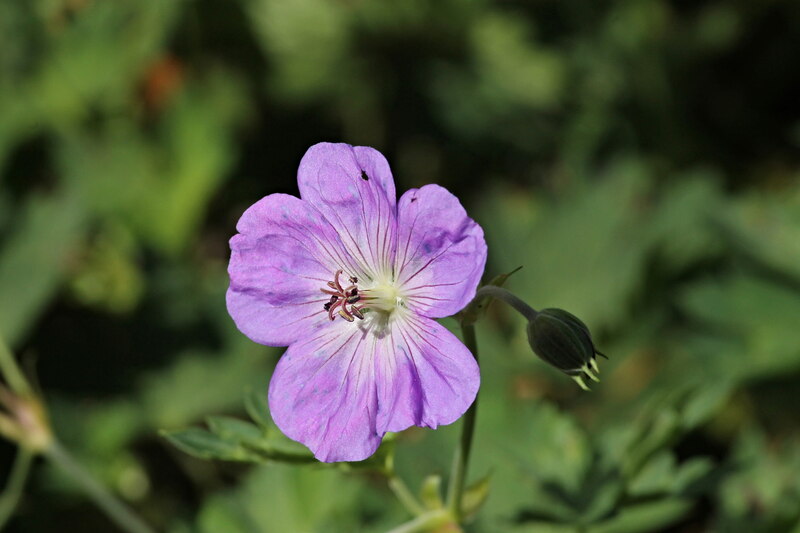
Photo Credit: PxFuel
Wild geranium is another herbaceous perennial with beautiful blooms, intricate foliage, and medicinal uses. This Tennessee native attracts mourning doves, quail, and white-tailed deer. Bright lavender flowers bloom in loose clusters atop long stems from March to July, attracting pollinators.
This shade-loving herb’s Intricate, lobed leaves can be boiled into tea to treat inflammation. Grow wild geranium in containers, shaded areas, flower beds, and rock gardens.
Growth habit: Herb
USDA hardiness zone: 3-8
Mature size: 1-2 feet tall
Duration: Perennial
Foliage: Semi-evergreen
Sunlight needs: Partial shade to full shade
Soil preferences: Prefers rich, acidic soil
Water needs: Water frequently; needs daily watering in the summer
Potential hazards: Non-toxic; edible; used medicinally as tea to fight inflammation
15. Wild Red Columbine (Aquilegia canadensis)
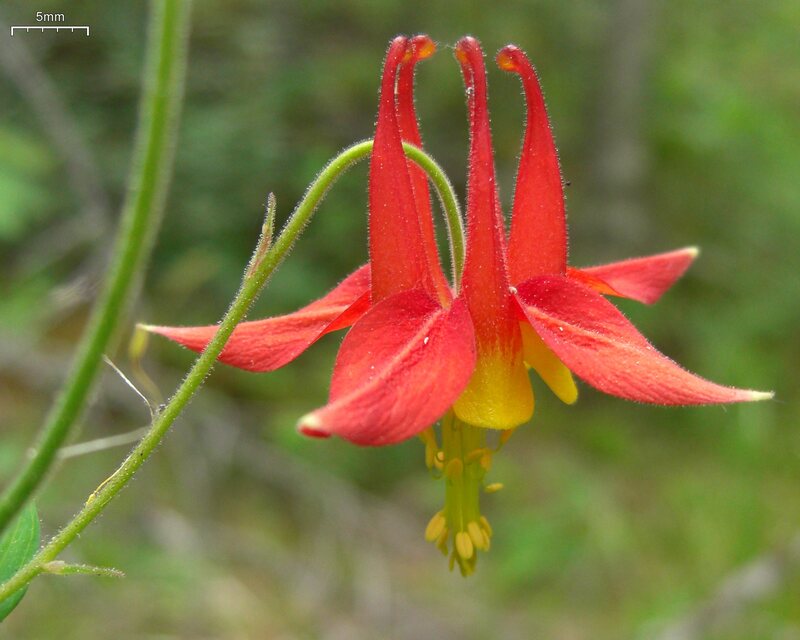
Photo Credit: Jason Hollinger / Wikimedia Commons / CC BY 2.0
Wild red columbine is a perennial herb and a member of the buttercup family. Also known as red Columbine, this Tennessee native grows up to 3 feet tall with showy, tuberous red and yellow blooms that droop, exposing bright yellow stamens.
Wild columbine has an erect growth pattern and bright green leaves. Its flowering tubes attract hummingbirds and butterflies and rabbits love to munch on its foliage. This herbaceous perennial prefers partial shade. Red columbine struggles when other plants compete with its root systems and prefer to grow alone as a groundcover in flower beds, at the edges of gardens, or in containers.
Growth habit: Herb
USDA hardiness zone: 3-8
Mature size: 1-4 feet tall
Duration: Perennial
Foliage: Semi-evergreen
Sunlight needs: Full sun to full shade; prefers partial shade
Soil preferences: Prefers neutral, sandy, well-drained sand, medium loam, sandy loam, or limestone-based soil
Water needs: Drought-tolerant; may need weekly watering during extreme dry spells; does not tolerate standing water
Potential hazards: Non-toxic; no safety hazards
16. Winterberry (Ilex verticillata)
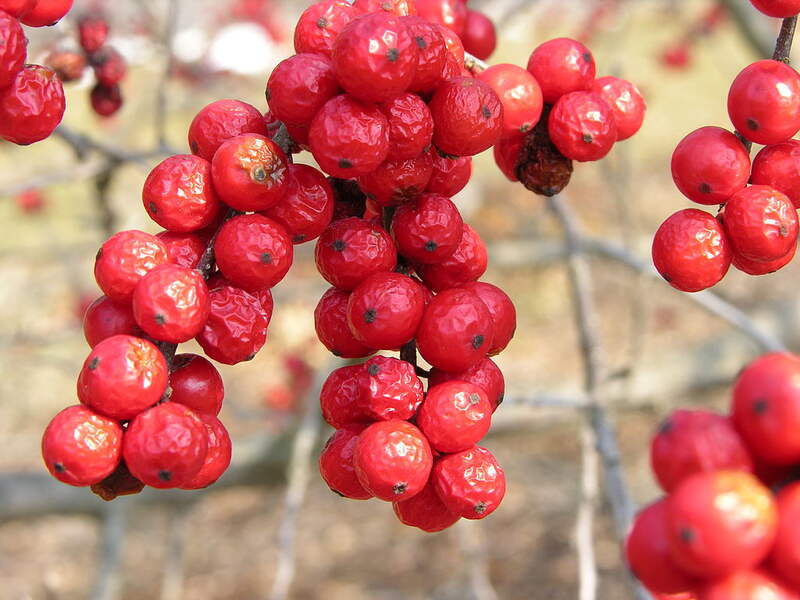
Photo Credit: Derek Ramsey / Wikimedia Commons / CC BY-SA 2.5
Winterberry is a deciduous tree in the holly family. This low-maintenance accent plant is often found in swamps, forest wetlands, and bogs. It grows well in mass plantings, shrub borders, wet soils, and near water.
Winterberry is the hardiest of all native hollies. Green and white-hued flowers bloom in June while some plants produce bright red berries in late summer that last through winter, attracting birds and wildlife. Winterberry is resistant to both pests and diseases.
Growth habit: Small tree or large shrub
USDA hardiness zone: 3-9
Mature size: 6-10 feet tall
Duration: Perennial
Foliage: Deciduous
Sunlight needs: Full sun to full shade; prefers partial shade
Soil preferences: Prefers moist, acidic soil, sand, loam, medium loam, clay loam, or clay
Water needs: High; ensure the soil is moist; water once per day during dry periods in spring and summer
Potential hazards: Moderate toxicity; fruits and foliage poisonous to humans
17. Woodland Phlox (Phlox divaricata)
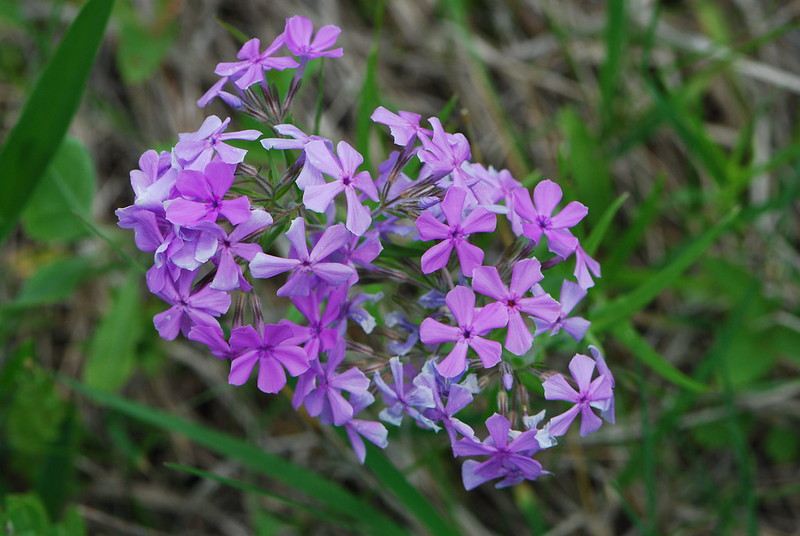
Photo Credit: Joshua Mayer / Flickr / CC BY-SA 2.0
Known in Murfreesboro as woodland phlox or wild blue phlox, this fragrant flowering plant forms colonies of showy star-shaped purple and blue blooms in spring as the plant crawls across unoccupied grounds. Woodland phlox works well in garden beds as a low-maintenance groundcover, mass plantings, and border edging.
This perennial herb has bright green foliage that rabbits love to nibble on and a dense growth pattern, making it a great hiding spot. It is deer-resistant and thrives in shady areas and most soil types.
Growth habit: Herb
USDA hardiness zone: 3-8
Mature size: Up to 20 inches tall
Duration: Perennial
Foliage: Evergreen
Sunlight needs: Partial shade to full shade
Soil preferences: Prefers rich, moist, acidic soils, sand, loam, medium loam, clay loam, and clay
Water needs: Maintain moist soil, ensuring the plant is never waterlogged; apply organic mulch to help retain moisture
Potential hazards: Non-toxic; no safety hazards
How to Choose Native Plants for Your Murfreesboro Yard
Your yard has its own unique microclimate, and all native plants have specific needs. Not all native plants will grow well in your yard. Be sure to select plants suitable for the soil, sun exposure, and watering capabilities of your landscape.
Murfreesboro sits in USDA Hardiness Zone 7a, indicating the coldest annual temperature is 0 to 5 degrees Fahrenheit. Tennessee native plants are cold-hardy to the minimum temperature in Murfreesboro’s hardiness zone. Keep your zone in mind when selecting non-native plants for your landscape.
FAQ About Native Murfreesboro Plants
Most flowers and shrubs should be planted after the last frost in late April. Check your local weather forecast before introducing new plants to your yard. Typically, the frost-free seasons last from April 20 to Oct. 11.
Murfreesboro’s diverse landscape is home to many soil types. Some areas consist of well-drained, fertile loam, while others are limestone-based or compacted clay. The best way to identify your landscape’s soil type is to send a sample of your soil in for testing to the local University of Tennessee extension office.
Early morning or evening are the best times to water your native plants. Winds are calmer and temperatures are lower, so there is less risk of water loss from evaporation or scorching from the sun. Additionally, foliage needs time to dry before nightfall. Wet foliage can lead to disease and rot.
Where to Find Native Plants in Murfreesboro
Chances are good you already have native plants in your yard or around your neighborhood. If you want to introduce more plants into your Murfreesboro landscape, be sure to source your plants ethically and never transplant them from the wild.
Check out these local nurseries in the Murfreesboro area:
Filling your yard with native plants is only one step in your landscaping design project. Be sure to maintain your new landscape with our spring lawn care tips for Murfreesboro and our fall lawn care checklist.
When you are ready to turn over the hard work and lawn upkeep to a professional, let WikiLawn connect you with a local landscaping pro in your area.
Main Image Credit: Hectonichus / Wikimedia Commons / CC BY-SA 3.0